Page 84 of 474
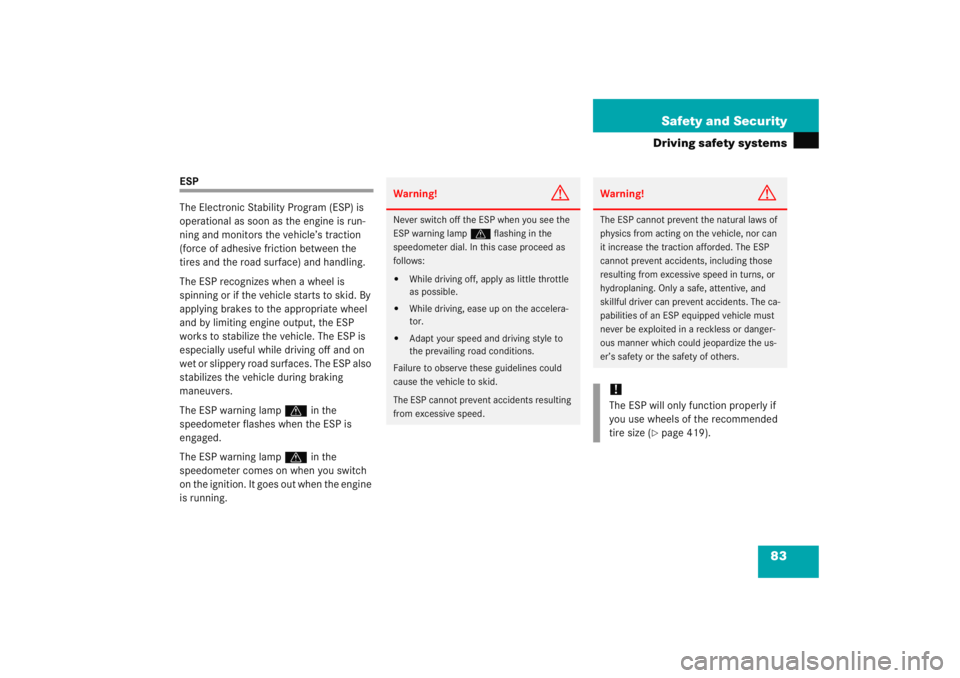
83
Safety and Security
Driving safety systems
ESP
The Electronic Stability Program (ESP) is
operational as soon as the engine is run-
ning and monitors the vehicle’s traction
(force of adhesive friction between the
tires and the road surface) and handling.
The ESP recognizes when a wheel is
spinning or if the vehicle starts to skid. By
applying brakes to the appropriate wheel
and by limiting engine output, the ESP
works to stabilize the vehicle. The ESP is
especially useful while driving off and on
wet or slippery road surfaces. The ESP also
stabilizes the vehicle during braking
maneuvers.
The ESP warning lamp
v in the
speedometer flashes when the ESP is
engaged.
The ESP warning lamp v in the
speedometer comes on when you switch
on the ignition. It goes out when the engine
is running.
Warning!
G
Never switch off the ESP when you see the
ESP warning lamp v flashing in the
speedometer dial. In this case proceed as
follows:�
While driving off, apply as little throttle
as possible.
�
While driving, ease up on the accelera-
tor.
�
Adapt your speed and driving style to
the prevailing road conditions.
Failure to observe these guidelines could
cause the vehicle to skid.
The ESP cannot prevent accidents resulting
from excessive speed.
Warning!
G
The ESP cannot prevent the natural laws of
physics from acting on the vehicle, nor can
it increase the traction afforded. The ESP
cannot prevent accidents, including those
resulting from excessive speed in turns, or
hydroplaning. Only a safe, attentive, and
skillful driver can prevent accidents. The ca-
pabilities of an ESP equipped vehicle must
never be exploited in a reckless or danger-
ous manner which could jeopardize the us-
er’s safety or the safety of others.!The ESP will only function properly if
you use wheels of the recommended
tire size (
�page 419).
Page 85 of 474

84 Safety and SecurityDriving safety systemsFor more information, see “Practical hints”
(�page 343).Switching off the ESP
To improve the vehicle’s traction, turn off
the ESP in driving situations where it would
be advantageous to have drive wheels spin
and thus cut into surfaces for better grip
such as:
�
starting out on slippery surfaces and in
deep snow in conjunction with snow
chains
�
sand or gravelWhen you switch off the ESP
�
the ESP does not stabilize the vehicle
�
the engine output is not limited, which
allows the drive wheels to spin and
thus cut into surfaces for better grip
�
the traction control will still brake a
spinning wheel
�
the ESP continues to operate when you
are braking
!Because of the ESP’s automatic opera-
tion, the engine must be shut off
(SmartKey in starter switch position
0
or 1) when �
the parking brake is being tested on
a brake test dynamometer
�
the vehicle is being towed with the
front axle raised
Active braking action through the ESP
may otherwise seriously damage the
rear axle brake system.
The ESP will only function properly if
you use wheels of the recommended
tire size.
Warning!
G
The ESP should not be switched off during
normal driving other than in the circum-
stances described below. Disabling of the
system will reduce vehicle stability in stan-
dard driving maneuvers.!Turn on the ESP immediately if the
aforementioned circumstances do not
apply anymore.
iWhen the ESP is switched off and one
or more drive wheels are spinning, the
ESP warning lamp v in the speed-
ometer flashes. However, the ESP will
then not stabilize the vehicle.
Page 86 of 474
85
Safety and Security
Driving safety systems
The switch is located on the center
console.
1 ESP switch (off/on)�
Press ESP switch 1.
The ESP warning lamp v in the
speedometer comes on.
The ESP is deactivated. Switching on the ESP
�
Press switch
1 again
The ESP warning lamp v in the
speedometer goes out.
You are now again in normal driving
mode with the ESP switched on.
Warning!
G
When the ESP warning lamp v is
illuminated continuously, the ESP is
switched off.
Adapt your speed and driving to the prevail-
ing road conditions and to the non-operating
status of the ESP.!Avoid spinning of a drive wheel for an
extended period with the ESP switched
off. This may cause serious damage to
the drivetrain which is not covered by
the Mercedes-Benz Limited Warranty.
Page 87 of 474
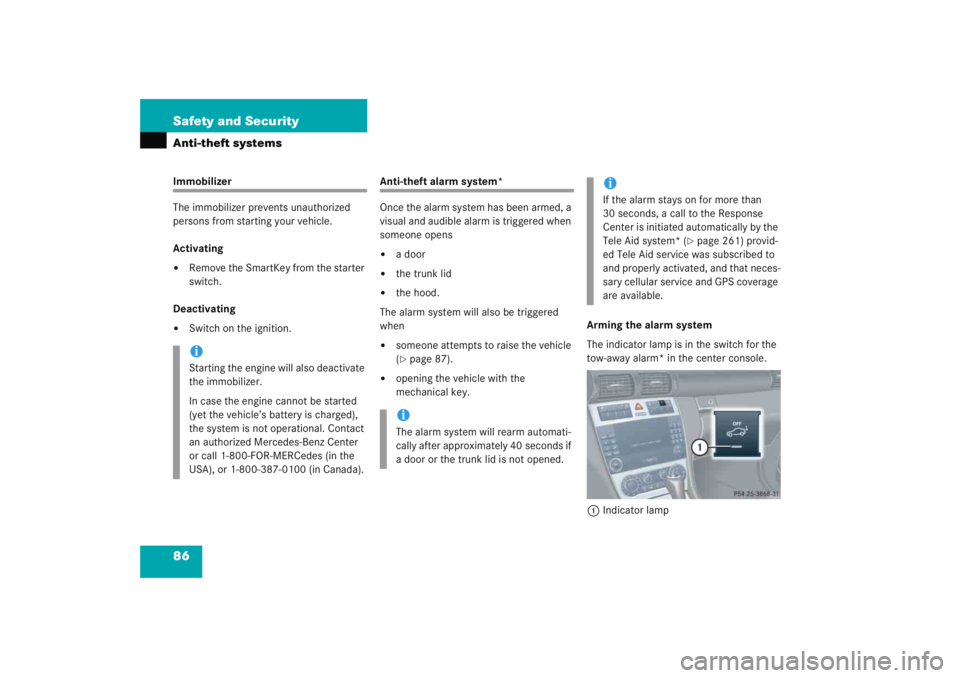
86 Safety and SecurityAnti-theft systemsImmobilizer
The immobilizer prevents unauthorized
persons from starting your vehicle.
Activating�
Remove the SmartKey from the starter
switch.
Deactivating
�
Switch on the ignition.
Anti-theft alarm system*
Once the alarm system has been armed, a
visual and audible alarm is triggered when
someone opens�
a door
�
the trunk lid
�
the hood.
The alarm system will also be triggered
when
�
someone attempts to raise the vehicle
(�page 87).
�
opening the vehicle with the
mechanical key. Arming the alarm system
The indicator lamp is in the switch for the
tow-away alarm* in the center console.
1 Indicator lamp
iStarting the engine will also deactivate
the immobilizer.
In case the engine cannot be started
(yet the vehicle’s battery is charged),
the system is not operational. Contact
an authorized Mercedes-Benz Center
or call 1-800-FOR-MERCedes (in the
USA), or 1-800-387-0100 (in Canada).
iThe alarm system will rearm automati-
cally after approximately 40 seconds if
a door or the trunk lid is not opened.
iIf the alarm stays on for more than
30 seconds, a call to the Response
Center is initiated automatically by the
Tele Aid system* (
�page 261) provid-
ed Tele Aid service was subscribed to
and properly activated, and that neces-
sary cellular service and GPS coverage
are available.
Page 88 of 474
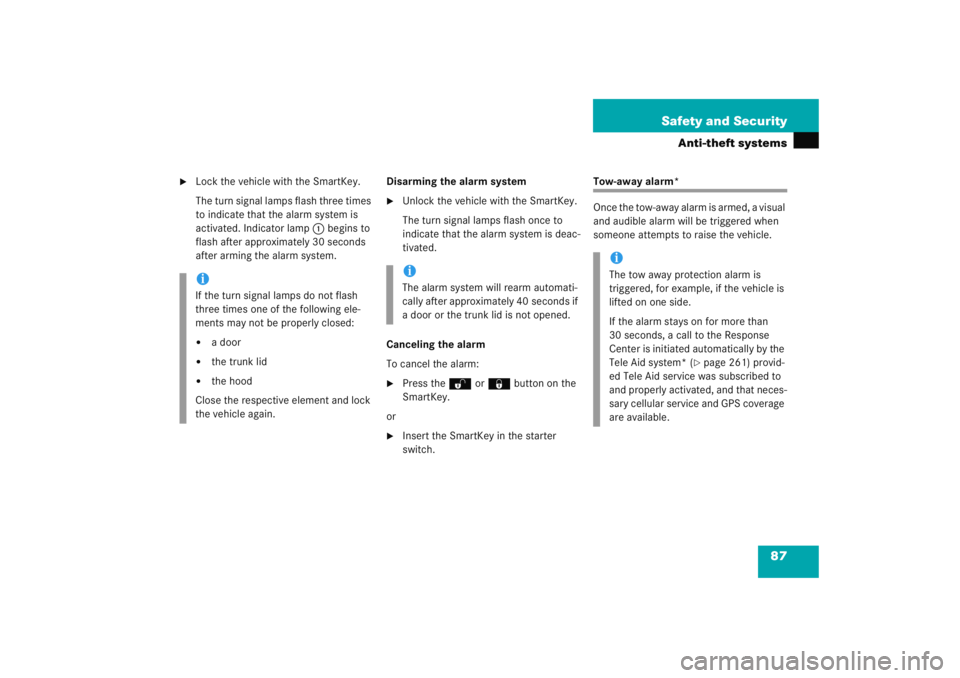
87
Safety and Security
Anti-theft systems
�
Lock the vehicle with the SmartKey.
The turn signal lamps flash three times
to indicate that the alarm system is
activated. Indicator lamp
1 begins to
flash after approximately 30 seconds
after arming the alarm system. Disarming the alarm system
�
Unlock the vehicle with the SmartKey.
The turn signal lamps flash once to
indicate that the alarm system is deac-
tivated.
Canceling the alarm
To cancel the alarm:
�
Press the Œ or ‹ button on the
SmartKey.
or
�
Insert the SmartKey in the starter
switch.
Tow-away alarm*
Once the tow-away alarm is armed, a visual
and audible alarm will be triggered when
someone attempts to raise the vehicle.
iIf the turn signal lamps do not flash
three times one of the following ele-
ments may not be properly closed:�
a door
�
the trunk lid
�
the hood
Close the respective element and lock
the vehicle again.
iThe alarm system will rearm automati-
cally after approximately 40 seconds if
a door or the trunk lid is not opened.
iThe tow away protection alarm is
triggered, for example, if the vehicle is
lifted on one side.
If the alarm stays on for more than
30 seconds, a call to the Response
Center is initiated automatically by the
Tele Aid system* (
�page 261) provid-
ed Tele Aid service was subscribed to
and properly activated, and that neces-
sary cellular service and GPS coverage
are available.
Page 91 of 474
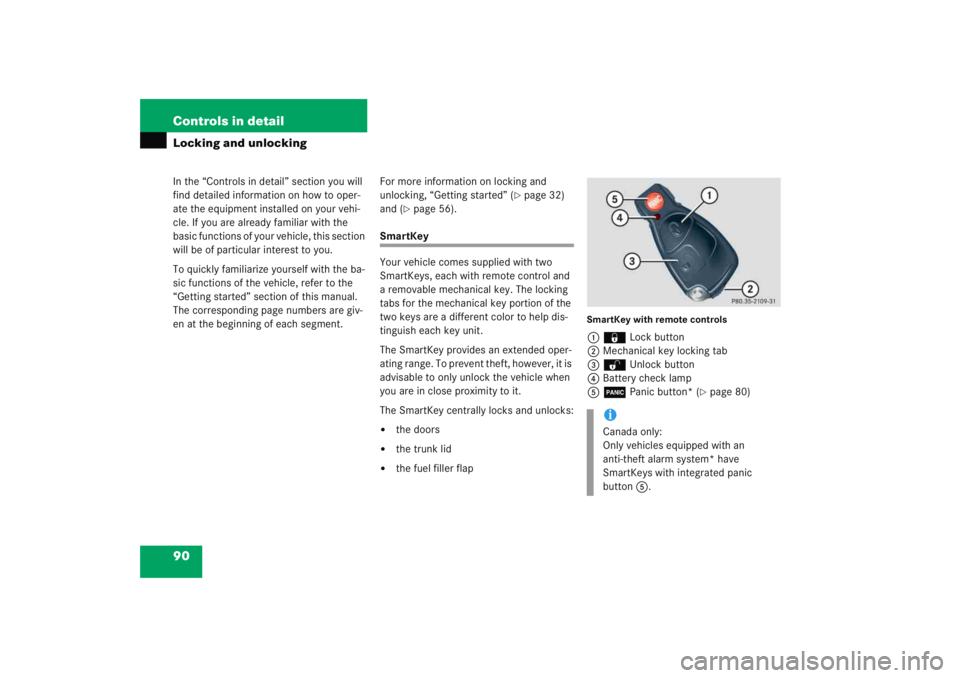
90 Controls in detailIn the “Controls in detail” section you will
find detailed information on how to oper-
ate the equipment installed on your vehi-
cle. If you are already familiar with the
basic functions of your vehicle, this section
will be of particular interest to you.
To quickly familiarize yourself with the ba-
sic functions of the vehicle, refer to the
“Getting started” section of this manual.
The corresponding page numbers are giv-
en at the beginning of each segment.Locking and unlocking
For more information on locking and
unlocking, “Getting started” (
�page 32)
and (
�page 56).
SmartKey
Your vehicle comes supplied with two
SmartKeys, each with remote control and
a removable mechanical key. The locking
tabs for the mechanical key portion of the
two keys are a different color to help dis-
tinguish each key unit.
The SmartKey provides an extended oper-
ating range. To prevent theft, however, it is
advisable to only unlock the vehicle when
you are in close proximity to it.
The SmartKey centrally locks and unlocks:�
the doors
�
the trunk lid
�
the fuel filler flap
SmartKey with remote controls1 ‹ Lock button
2 Mechanical key locking tab
3 ΠUnlock button
4 Battery check lamp
5 Â Panic button* (
�page 80)
iCanada only:
Only vehicles equipped with an
anti-theft alarm system* have
SmartKeys with integrated panic
button 5.
Page 97 of 474
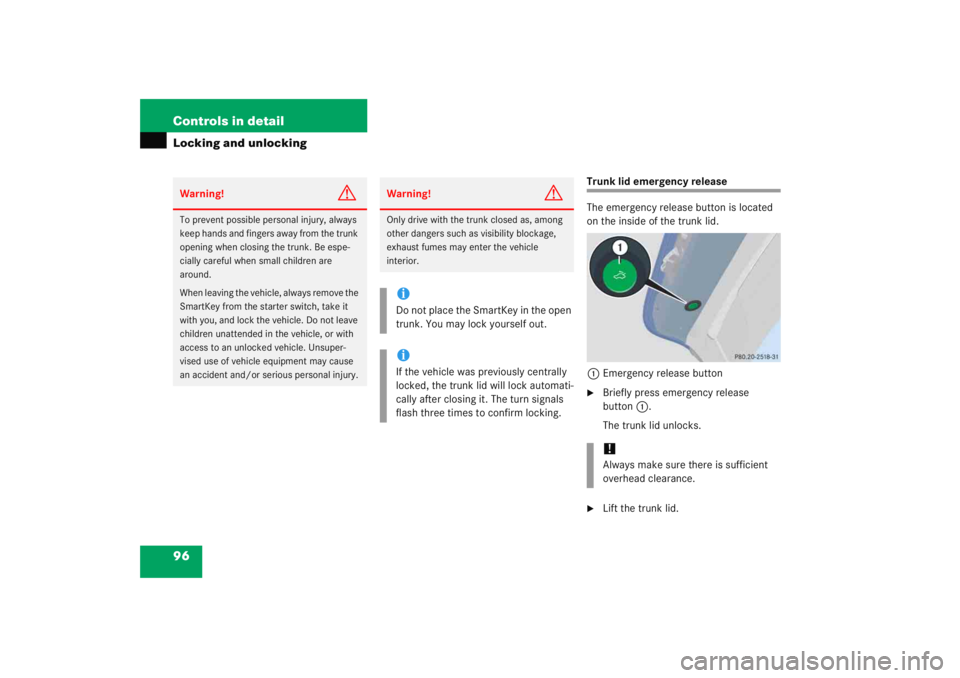
96 Controls in detailLocking and unlocking
Trunk lid emergency release
The emergency release button is located
on the inside of the trunk lid.1 Emergency release button�
Briefly press emergency release
button 1.
The trunk lid unlocks.
�
Lift the trunk lid.
Warning!
G
To prevent possible personal injury, always
keep hands and fingers away from the trunk
opening when closing the trunk. Be espe-
cially careful when small children are
around.
When leaving the vehicle, always remove the
SmartKey from the starter switch, take it
with you, and lock the vehicle. Do not leave
children unattended in the vehicle, or with
access to an unlocked vehicle. Unsuper-
vised use of vehicle equipment may cause
an accident and/or serious personal injury.
Warning!
G
Only drive with the trunk closed as, among
other dangers such as visibility blockage,
exhaust fumes may enter the vehicle
interior.iDo not place the SmartKey in the open
trunk. You may lock yourself out.iIf the vehicle was previously centrally
locked, the trunk lid will lock automati-
cally after closing it. The turn signals
flash three times to confirm locking.
!Always make sure there is sufficient
overhead clearance.
Page 102 of 474
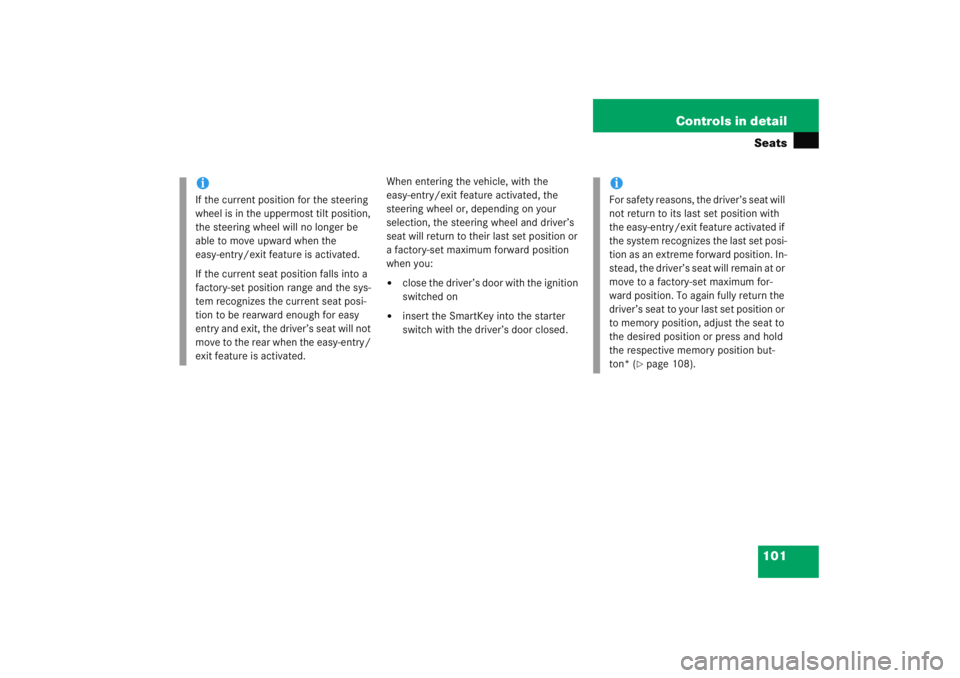
101
Controls in detailSeats
When entering the vehicle, with the
easy-entry/exit feature activated, the
steering wheel or, depending on your
selection, the steering wheel and driver’s
seat will return to their last set position or
a factory-set maximum forward position
when you:�
close the driver’s door with the ignition
switched on
�
insert the SmartKey into the starter
switch with the driver’s door closed.
iIf the current position for the steering
wheel is in the uppermost tilt position,
the steering wheel will no longer be
able to move upward when the
easy-entry/exit feature is activated.
If the current seat position falls into a
factory-set position range and the sys-
tem recognizes the current seat posi-
tion to be rearward enough for easy
entry and exit, the driver’s seat will not
move to the rear when the easy-entry/
exit feature is activated.
iFor safety reasons, the driver’s seat will
not return to its last set position with
the easy-entry/exit feature activated if
the system recognizes the last set posi-
tion as an extreme forward position. In-
stead, the driver’s seat will remain at or
move to a factory-set maximum for-
ward position. To again fully return the
driver’s seat to your last set position or
to memory position, adjust the seat to
the desired position or press and hold
the respective memory position but-
ton* (
�page 108).